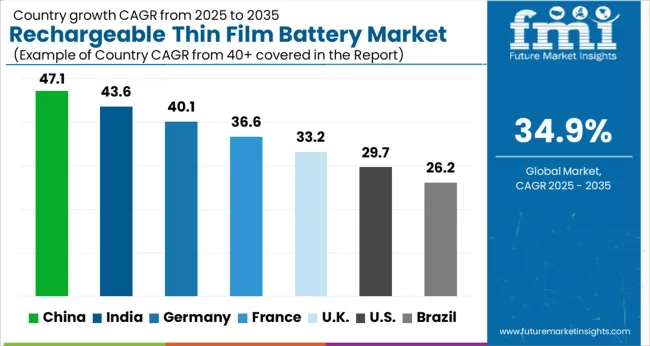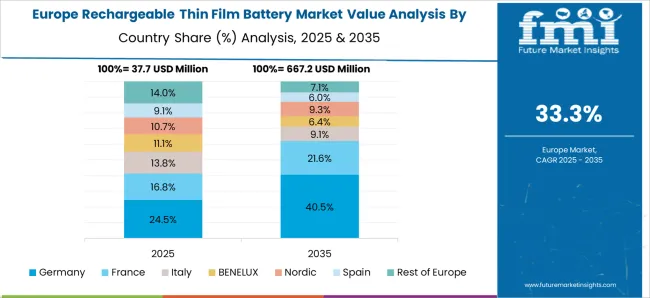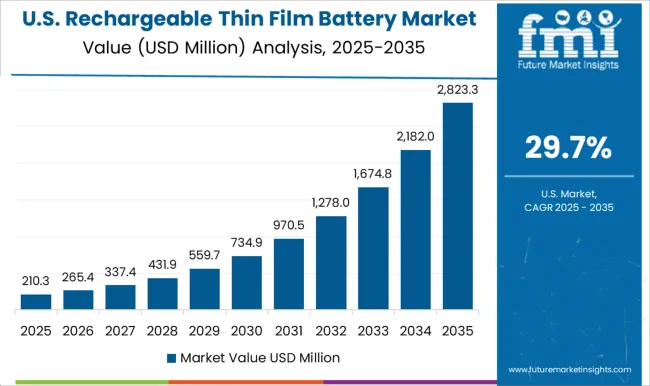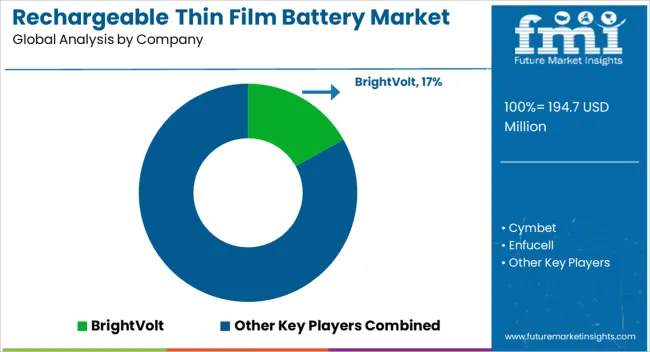The rechargeable thin film battery market is estimated to be valued at USD 194.7 million in 2025 and is projected to reach USD 3885.1 million by 2035, registering a compound annual growth rate (CAGR) of 34.9% over the forecast period. This long-term value accumulation curve highlights a significant acceleration in market adoption driven by growing demand for compact, high-energy-density storage solutions. Annual growth shows a steady rise from USD 262.6 million in 2026 to USD 2,880 million in 2034, underscoring the market’s rapid penetration across sectors that prioritize miniaturized energy storage and efficient power delivery.
Market dynamics are influenced by end-user demand in consumer electronics, medical devices, and specialized industrial applications, where performance consistency and space efficiency are prioritized. The rechargeable thin film battery market demonstrates a pronounced growth trajectory, reinforced by increased adoption across multiple industries requiring reliable and compact energy storage. The year-on-year accumulation illustrates that incremental market investments and strategic manufacturing expansions are facilitating large-scale deployment.
Demand for thin film batteries is being strengthened by their superior energy density, lightweight design, and adaptability to constrained form factors, which position them as favorable alternatives to conventional battery technologies. Market behavior indicates that strategic partnerships, capacity enhancements, and targeted commercialization initiatives are contributing to a sustained and rapidly expanding market presence over the decade.

| Metric | Value |
|---|---|
| Rechargeable Thin Film Battery Market Estimated Value in (2025 E) | USD 194.7 million |
| Rechargeable Thin Film Battery Market Forecast Value in (2035 F) | USD 3885.1 million |
| Forecast CAGR (2025 to 2035) | 34.9% |
The rechargeable thin film battery market has been observed to hold a notable share within its parent markets, accounting for approximately 12-14% of the lithium-ion battery market, around 10-12% of the energy storage systems market, close to 18-20% of the wearable electronics battery market, about 8-10% of the consumer electronics battery market, and roughly 7-9% of the advanced battery materials market. When aggregated, these contributions indicate a combined share in the range of 55-65%, demonstrating the growing adoption of thin film batteries in specialized applications where compact size, lightweight, and flexible form factors are critical.
The market has been driven by increasing demand for portable, low-profile, and high-efficiency power sources in sectors such as medical devices, smart cards, wearable gadgets, and IoT devices. Adoption has been influenced by the performance characteristics of rechargeable thin film batteries, including high energy density, fast charging capability, and long cycle life, which have positioned them as an attractive alternative to conventional battery technologies in niche applications.
Industry participants have been focusing on optimizing battery chemistry, reducing manufacturing costs, and ensuring integration compatibility with electronic devices to capture a wider application base. As a result, the rechargeable thin film battery market has secured a meaningful presence across lithium-ion, wearable electronics, and energy storage segments, underlining its strategic role in enabling miniaturized, portable, and reliable power solutions.
The rechargeable thin film battery market is experiencing strong momentum as miniaturized, energy-efficient power solutions become essential across emerging electronic applications. These batteries are characterized by their compact form factor, lightweight design, and ability to support flexible and wearable devices, making them ideal for next-generation consumer electronics and IoT deployments.
Increasing adoption of smart technologies in healthcare, fitness, and industrial sectors is driving the integration of thin film batteries into ultra-compact electronic systems. Their enhanced safety profile, faster charging capabilities, and long cycle life further contribute to their growing preference over traditional lithium-ion solutions.
Ongoing advancements in solid-state battery architecture and rising investments in nanomaterial development are expected to broaden application possibilities and performance standards. As the demand for flexible, durable, and efficient energy storage solutions escalates, thin film battery technology is poised to play a critical role in powering the future of connected, wearable, and sensor-driven environments.
The rechargeable thin film battery market is segmented by application, and geographic regions. By application, rechargeable thin film battery market is divided into Wearable Devices, Medical, Smart Cards, Consumer Products, and Others. Regionally, the rechargeable thin film battery industry is classified into North America, Latin America, Western Europe, Eastern Europe, Balkan & Baltic Countries, Russia & Belarus, Central Asia, East Asia, South Asia & Pacific, and the Middle East & Africa.

The wearable devices segment leads the application category with a 38.6% market share, reflecting its significant role in driving demand for rechargeable thin film batteries. These batteries are uniquely suited for wearables due to their ultra-thin structure, mechanical flexibility, and ability to conform to curved surfaces without compromising energy output.
The segment’s growth is being propelled by increasing consumer adoption of fitness trackers, smartwatches, and medical monitoring devices that demand compact and reliable power sources. Additionally, the rise of continuous health monitoring and remote patient care has expanded the scope of battery-powered wearable technologies.
Manufacturers are actively enhancing battery performance to deliver longer operational life, faster charging, and improved thermal stability, all crucial features for user satisfaction and device safety. As innovation in flexible electronics continues, the demand for thin film batteries in wearable applications is expected to remain robust, reinforcing the segment’s leadership in the market.
The rechargeable thin film battery market is being propelled by demand from compact electronics, wearable devices, and medical sensors. Opportunities are expanding through flexible, energy-dense solutions and strategic collaborations with device manufacturers. Trends emphasize miniaturization, integration with smart electronics, and high-performance energy storage. Challenges such as high production costs, scalability limitations, and material constraints continue to shape adoption strategies. Overall, the market is expected to grow steadily as electronic devices increasingly require slim, lightweight, and reliable power solutions that align with modern design and functional requirements.
The rechargeable thin film battery market is experiencing robust demand primarily fueled by the proliferation of compact, portable electronic devices and wearable technologies. Devices such as smartwatches, medical sensors, hearing aids, and micro-electronics are increasingly relying on thin film batteries due to their slim profile, lightweight design, and high energy density. The demand is also being influenced by the need for longer device lifespans and reliable power supply in medical, consumer, and industrial applications.
Consumer preference for sleek, lightweight, and portable devices is pushing manufacturers to adopt thin film batteries that can deliver consistent performance without compromising device form factor. Regional adoption patterns reveal that North America and Europe lead in premium electronics integration, while Asia-Pacific is witnessing accelerating uptake due to expanding electronics manufacturing hubs. Moreover, battery miniaturization requirements in emerging IoT and wearable applications are further strengthening market demand, positioning rechargeable thin film batteries as essential components in next-generation electronics.
Opportunities in the rechargeable thin film battery market are being significantly shaped by the demand for energy-dense, flexible, and micro-scale power solutions. The ability of thin film batteries to deliver consistent voltage in a small footprint creates new possibilities for wearable electronics, medical implants, and smart sensors. Integration with flexible substrates and printed electronics is being leveraged to design next-generation consumer and industrial devices. Collaborations between battery manufacturers and electronic device producers are enhancing opportunities to co-develop customized solutions optimized for specific applications. Emerging markets present additional potential as electronics adoption increases in healthcare, consumer gadgets, and industrial automation. Furthermore, research into high-capacity thin film chemistries and hybrid configurations is opening avenues for enhanced performance and application diversification. Opportunities are also being created by the growing emphasis on device miniaturization, lightweight energy storage, and portable electronic solutions that demand consistent, long-lasting power supply.
Market trends in rechargeable thin film batteries are increasingly influenced by the drive toward device miniaturization, integration with smart electronics, and high-performance energy storage. Thin film batteries are being deployed in compact designs where conventional batteries fail to meet space and weight constraints. The adoption of micro-batteries in medical implants, sensors, and wearable devices has grown, reflecting a broader trend toward seamless integration and energy efficiency. Flexible substrates and printed electronics are being combined with thin film batteries to expand design possibilities and maintain form factor integrity. Additionally, device manufacturers are focusing on enhancing cycle life, energy density, and charge retention, reflecting a trend toward longer-lasting, maintenance-free power solutions. Regions with high consumer electronics demand are witnessing increased integration of thin film batteries into new product lines. The trend toward compact, high-performance, and integrated power solutions is redefining design and functionality across electronics applications.
Challenges in the rechargeable thin film battery market are primarily linked to high manufacturing costs, complex production processes, and scalability constraints. Thin film battery fabrication requires precision equipment and controlled environments to ensure uniform layer deposition and energy density, which elevates production costs. Scaling up manufacturing while maintaining consistent quality and performance poses significant hurdles for suppliers. Additionally, material availability and compatibility with flexible electronics can introduce technical challenges in product design. Lifecycle management, recycling, and regulatory compliance further complicate operational strategies. Emerging applications require customization, which adds cost and slows widespread adoption. Furthermore, competition from conventional lithium-ion micro-batteries and other energy storage technologies may hinder market penetration unless cost reductions and performance enhancements are achieved. Manufacturers must navigate these challenges carefully to maintain profitability while meeting growing demand.

| Country | CAGR |
|---|---|
| China | 47.1% |
| India | 43.6% |
| Germany | 40.1% |
| France | 36.6% |
| UK | 33.2% |
| USA | 29.7% |
| Brazil | 26.2% |
The global rechargeable thin film battery market is projected to grow at a CAGR of 34.9% from 2025 to 2035. China leads with a growth rate of 47.1%, followed by India at 43.6%, and France at 36.6%. The United Kingdom records a growth rate of 33.2%, while the United States shows the slowest growth at 29.7%. Expansion is driven by increasing demand for compact, high-energy-density batteries in consumer electronics, wearables, medical devices, and electric mobility. Emerging markets such as China and India witness higher growth due to rapid electronics manufacturing, increasing adoption of portable devices, and government support for battery technology, while developed markets focus on integrating thin film batteries into advanced electronics, renewable energy storage solutions, and IoT applications. This report includes insights on 40+ countries; the top markets are shown here for reference.
The rechargeable thin film battery market in China is expanding at a CAGR of 47.1%, driven by strong demand from consumer electronics, wearable devices, and electric mobility sectors. Chinese manufacturers are investing heavily in research and development to improve battery energy density, charging efficiency, and lifespan. Government initiatives promoting clean energy and portable electronics further enhance adoption. The country benefits from a robust supply chain for battery materials, advanced manufacturing capabilities, and significant exports of electronic devices. Growth is also fueled by increasing integration of thin film batteries into IoT devices, healthcare wearables, and electric vehicle components, which require compact and reliable power solutions.
The rechargeable thin film battery market in India is growing at a CAGR of 43.6%, supported by rising consumer electronics production and increasing wearable device usage. Local manufacturers are investing in thin film battery technology to improve performance, portability, and energy efficiency. Market growth is further reinforced by government incentives for energy storage technologies and initiatives promoting clean energy adoption. The increasing demand for compact batteries in medical devices, mobile electronics, and IoT applications drives market expansion. India’s electronics and renewable energy sectors provide a fertile ground for thin film battery integration, creating opportunities for both domestic and international manufacturers.

The rechargeable thin film battery market in France is projected to grow at a CAGR of 36.6%, driven by integration in consumer electronics, automotive, and medical sectors. French manufacturers focus on developing high-performance, compact batteries suitable for portable electronics and renewable energy storage systems. Market growth is supported by research initiatives, technological collaborations, and increasing adoption of IoT devices and wearables. Additionally, government programs promoting energy efficiency, sustainability, and smart electronics adoption strengthen market expansion. Demand is also influenced by the growing use of thin film batteries in electric mobility and healthcare applications, where compact, lightweight, and durable power sources are essential.
The rechargeable thin film battery market in the United Kingdom is expected to grow at a CAGR of 33.2%, with steady adoption in consumer electronics, healthcare devices, and energy storage applications. The UK market is characterized by investments in high-efficiency, compact battery solutions that improve device portability and operational lifespan. Growth is fueled by increasing demand for wearables, IoT devices, and renewable energy integration. Research programs and industrial collaborations also promote innovation in thin film battery technology. While growth is moderate compared to China and India, the UK continues to expand adoption through advanced electronic devices and smart energy solutions.

The rechargeable thin film battery market in the United States is growing at a CAGR of 29.7%, driven by demand from portable electronics, healthcare wearables, and renewable energy storage. USA manufacturers are focusing on improving battery performance, longevity, and compactness for integration into smart devices and IoT applications. Market growth is further supported by government incentives for clean energy adoption and research programs targeting next-generation energy storage solutions. While growth is slower than in emerging markets, the USAcontinues to see increasing adoption in electronics, medical devices, and electric mobility sectors, creating opportunities for both domestic production and international partnerships.

The rechargeable thin film battery market has witnessed notable expansion in recent years, driven by the growing need for compact, lightweight, and flexible energy storage solutions across various industries, including consumer electronics, medical devices, wearable technology, and IoT applications. Key players such as BrightVolt, Cymbet, Enfucell, and Ilika are leading the market by developing batteries that offer high energy density, rapid charge-discharge cycles, and long lifecycle performance. Companies like Imprint Energy, Ion Storage Systems, ITEN, and Jenax focus on innovation in solid-state and thin-film technologies, enabling devices to achieve miniaturization without compromising on energy output. Additionally, firms including Johnson Energy Storage, Molex, Prieto Battery, and STMicroelectronics provide customized solutions tailored to specific industry requirements, integrating advanced materials and flexible form factors. Strategic partnerships, collaborations, and continuous research and development are instrumental in enhancing performance, reducing costs, and expanding application areas, which underscores the dynamic nature of this market.
The market growth is further fueled by the rising adoption of wearable electronics, implantable medical devices, smart sensors, and wireless IoT devices, which require reliable and space-efficient energy solutions. Companies are increasingly focusing on enhancing battery safety, durability, and environmental sustainability, prompting innovation in non-toxic materials, solid electrolytes, and recyclable battery components. The integration of rechargeable thin film batteries into smart devices also promotes energy efficiency, seamless connectivity, and extended device longevity, meeting the growing expectations of end-users. Furthermore, technological advancements in deposition techniques, nanomaterials, and manufacturing processes are contributing to better energy density and faster charging capabilities. With increasing investment in research, expansion of applications in consumer electronics, healthcare, and industrial sectors, and a focus on eco-friendly energy storage, the rechargeable thin film battery market is poised for significant growth, driven by both technological innovation and rising global demand for compact, high-performance energy solutions.
| Item | Value |
|---|---|
| Quantitative Units | USD 194.7 Million |
| Application | Wearable Devices, Medical, Smart Cards, Consumer Products, and Others |
| Regions Covered | North America, Europe, Asia-Pacific, Latin America, Middle East & Africa |
| Country Covered | United States, Canada, Germany, France, United Kingdom, China, Japan, India, Brazil, South Africa |
| Key Companies Profiled | BrightVolt, Cymbet, Enfucell, Ilika, Imprint Energy, Ion Storage Systems, ITEN, Jenax, Johnson Energy Storage, Molex, Prieto Battery, and STMicroelectronics |
| Additional Attributes | Dollar sales by battery type (lithium-ion, solid-state, polymer) and application (wearables, IoT devices, medical devices, consumer electronics) are key metrics. Trends include rising demand for compact, high-energy-density batteries, growth in portable and flexible electronics, and increasing adoption in next-generation devices. Regional deployment, technological advancements, and regulatory compliance are driving market growth. |
The global rechargeable thin film battery market is estimated to be valued at USD 194.7 million in 2025.
The market size for the rechargeable thin film battery market is projected to reach USD 3,885.1 million by 2035.
The rechargeable thin film battery market is expected to grow at a 34.9% CAGR between 2025 and 2035.
The key product types in rechargeable thin film battery market are wearable devices, medical, smart cards, consumer products and others.
Explore Similar Insights

Thank you!
You will receive an email from our Business Development Manager. Please be sure to check your SPAM/JUNK folder too.
Chat With
MaRIA